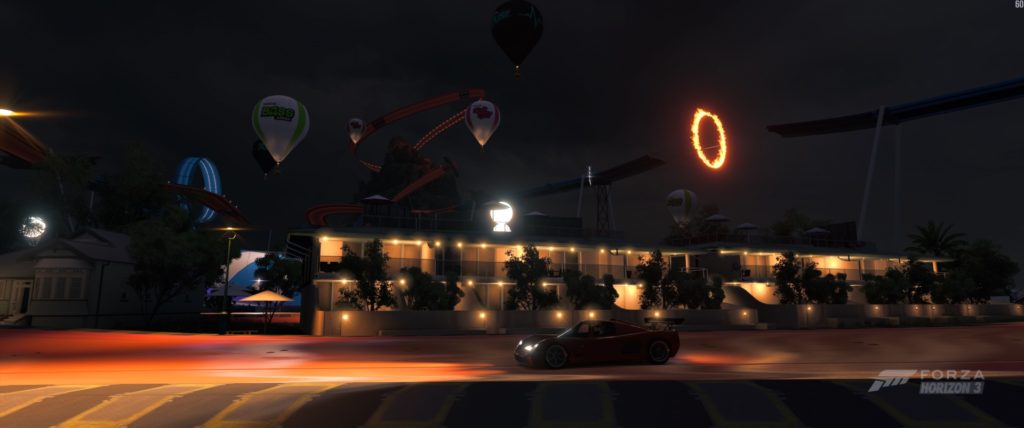See original post covering Forza Horizon 3
- Genre: Open World Racing
- Platform: Windows 10 (Microsoft Store – Digital Only)
- Also Available On: Xbox One
This screenshot is the best quick peak I can really give to describe this expansion. There’s a loop in the back left, some obligatory fire in the right, and an entire mountain covered in looping track in the center. This is as close as you’ll get to your childhood fantasy of driving a full size Hot Wheels car in a full size Hot Wheels universe, and damn is it a lot of fun.
This is the second expansion released as post-release content for Forza Horizon 3. The first one, Blizzard Mountain, added a bunch of snow-focused rally events that were solid but didn’t stray too far from the core gameplay established in the base game. Horizon Hot Wheels throws the idea of the base game out the window. All of the expectations of a Hot Wheels theme are there. There’s brightly colored blue and orange track (with the all important little side walls) built in impossible angles to drive around on. There’s soaring banks and loops that seem impossible to drive on (and yes, you can fall off if you’re going too slow at the top of a loop). There’s gigantic jumps everywhere, most of the time preceded by a little black boost pad to really get you up to speed. There’s even an occasional T-Rex there just to make sure things stay grounded in reality. Despite it all, this still works as a solid Forza experience.
While Horizon has always leaned distinctly more towards arcade than the core Forza titles, it still had a relatively realistic feel to driving, and that’s maintained here. The best times are still going to be had by paying attention to your breaking lines and properly hitting corners. However, the track designs greatly changed how I approached racing. My preferred setup has always been the cockpit view, and the ability to see where I’m going in a standard car on standard roads was never a problem. What I didn’t take into account is the fact that I may be turning UP, instead of left and right, and that’s the biggest gameplay change that the Hot Wheels expansion brings to the table. Because of the significant inclusion of things like loops or Immelmann loops, I tended to heavily lean on cars that either had significantly large windshields, or cars that were roll cage only, giving me a lot more ability to see where the corners were approaching in a completely foreign direction from what I was used to.
That said, not everything worked out fantastically. The Hot Wheels cars themselves were unsurprisingly bad at being cars. The designs have always been hilariously impractical as actual car designs, but having the cool looking toy and actually trying to drive the cars are two different things. This is especially bad when you can’t actually see where you’re going:
Yep, that’s a big ol engine block in the way. The designs that are there are definitely authentic to the originals, but I tended to stick with normal cars when I could just for playability. The AI also was having some significant problems adjusting to the strange track designs, particularly in high speed banks where turning really wasn’t that important. I can’t recall more than a handful of times where I really saw the AI ever flip over in the base game, but it was pretty routine to see multiple cars in a race go flying off the track to their doom here. The AI also felt like it had some adjustments to its rubberbanding since I last played, because the AI was often pulling off impossible feats in acceleration to pass me. I’ve never driven the Halo Warthog, but I king of suspect it can’t out accelerate a Jaguar F-Type.
However, the things I found wrong were at best minor nitpicks. They’re immediately forgotten the first time you go off a blind jump through a fire hoop, see the car tilting up, and just watch the sky for seconds at a time not really knowing when you’re going to land. It’s those kinds of outlandish moments that make this feel like playing in a giant Hot Wheels set, despite still feeling like Forza.




